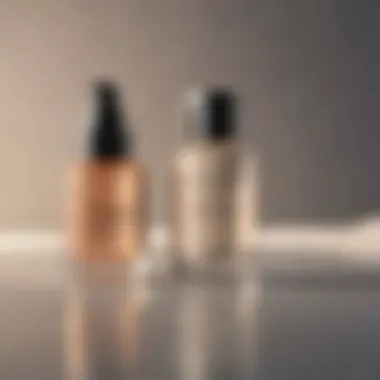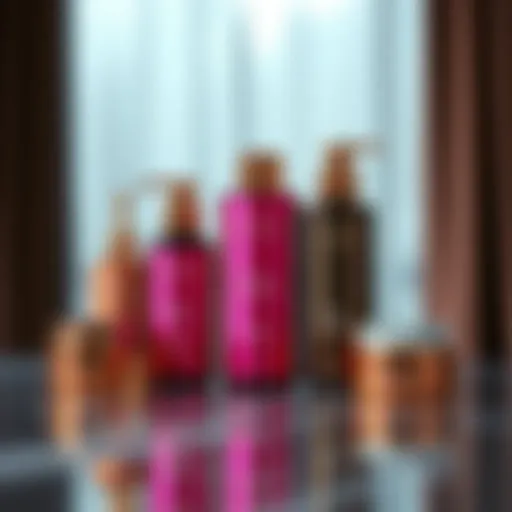The Best Facial Serums for Hydrating Dry Skin


Intro
In the quest for radiant and hydrated skin, understanding the optimal facial serums for dry skin is crucial. This guide delves deep into various facets of facial serums, analyzing their ingredients, benefits, and application techniques. The information presented is designed to assist individuals with dry skin in making informed decisions about their skincare. With the rise of specialized products, knowing which serums effectively address dryness can greatly enhance your skincare regimen.
Tips and How-Tos
Skincare Routines for Different Skin Types
Having a solid skincare routine is paramount, especially for those with dry skin. Hydration is key, and using a suitable serum can make a significant difference. Here are some recommendations:
- Morning Routine: Start with a gentle cleanser to remove impurities. Follow with a hydrating serum containing hyaluronic acid or glycerin, which are known for their moisture-retaining properties. Finish with a broad-spectrum sunscreen.
- Evening Routine: Repeat the cleansing step. Apply a nourishing serum that may include ingredients like squalane or ceramides, both of which support skin barrier function and retain moisture overnight. Follow with a rich moisturizer to lock in hydration.
Important Considerations:
- Choose serums that are fragrance-free to avoid irritation.
- Pay attention to seasonal changes; you may need a more intense formula in winter months.
Hydrated skin is not just about moisture; it also involves the balance of oil and water.
Product Recommendations
A few standout serums that you may consider include:
- The Ordinary Hyaluronic Acid 2% + B5: Provides intense hydration at a budget-friendly price.
- Vichy Mineral 89: A lightweight serum that strengthens skin’s barrier.
- Drunk Elephant B-Hydra Intensive Hydration Serum: Known for its ability to deliver steady hydration.
Sustainable Practices
Eco-Friendly Skincare Brands
As consumers become more environmentally aware, the demand for sustainable skincare products grows. Brands like Tatcha, which sources ingredients responsibly, and Herbivore Botanicals, known for their eco-friendly packaging, are paving the way. Look for certifications like cruelty-free and organic to ensure ethical practices.
Tips for Sustainable Grooming
- Avoid Single-Use Plastics: Opt for products with refillable options.
- Be Mindful of Ingredients: Choose serums free from harmful chemicals and those with a transparent sourcing process.
Celebrating Diversity in Beauty
Inclusive Beauty Brands
A range of brands now celebrates diversity in beauty by catering to various skin tones and types. Brands like Fenty Beauty and L’Oreal focus on inclusivity, providing products suitable for all skin textures and colors.
Cultural Influences on Fashion
Understanding cultural differences in beauty standards helps expand one’s knowledge. Regions around the world embrace distinct practices. For example, the use of ayurvedic treatments in India or the significance of rice water in East Asian skincare routines illustrates how cultural traditions shape beauty standards.
Understanding Dry Skin
Understanding dry skin is an essential aspect of selecting the right facial serum. The condition goes beyond mere aesthetics; it dictates how well products can perform in providing moisture and nourishment. Knowing the intricacies of dry skin helps in identifying the specific needs and challenges one faces.
Nourishment is crucial for the skin since it serves as a protective barrier against environmental aggressors. When this barrier is compromised, it can lead to discomfort, irritation, and even inflammation. This article delves into the fundamental components of dry skin, aiding readers in making informed choices about serums that can restore and maintain skin hydration.
The Anatomy of Dry Skin
Dry skin typically lacks sufficient moisture and lipids, leading to a rough texture. At a physiological level, the skin has three layers: the epidermis, dermis, and subcutaneous tissue. The outer layer, the epidermis, plays a vital role in protection and moisture retention.
When the epidermis is functioning well, it maintains a balanced moisture level. However, with dry skin, this layer often appears flaky and dull. The sebaceous glands, located in the dermis, produce natural oils that are essential for hydration. If these oils are insufficient, the skin appears parched and can feel tight or itchy.
Causes of Dry Skin
Multiple factors can contribute to the development of dry skin. Understanding these causes is crucial for prevention and management. Some common causes include:
- Environmental Conditions: Cold weather, low humidity, and excessive sun exposure can all strip moisture from the skin.
- Skin Care Habits: Over-cleansing, using harsh soaps, or applying lotions containing alcohol can exacerbate dryness.
- Medical Conditions: Certain conditions, like eczema or psoriasis, inherently cause dryness.
- Age: As individuals age, skin loses its natural lipid barrier, leading to more pronounced dryness.
- Diet and Hydration: A diet low in essential fatty acids and inadequate water intake can also impact skin hydration.
Symptoms of Dry Skin
Recognizing the symptoms of dry skin is vital. Typical signs may include:


- Flakiness: Skin may visibly peel or appear scaly.
- Tightness: A sensation of tension or tightness following cleansing.
- Redness or Irritation: Inflammation can arise, especially if the dryness is severe.
- Itching: Often, dryness triggers an urge to scratch, which can worsen the condition.
- Cracking: In extreme cases, skin may crack and bleed, necessitating medical attention.
"Understanding the symptoms of dry skin allows for a targeted approach in selecting effective serums."
Addressing these symptoms proactively can help in choosing the right serum designed for hydrating dry skin effectively. By providing clear information on the structure, causes, and signs of dry skin, this section sets the stage for discussing facial serums that can address these challenges.
What is a Facial Serum?
Understanding what a facial serum is plays a crucial role in identifying the best products for dry skin. A facial serum is a potent skincare solution designed to deliver a high concentration of active ingredients deep into the skin. The fine consistency of serums allows them to penetrate the skin more effectively than traditional moisturizers. In this section, we will define facial serums, examine how they differ from moisturizers, and discuss their essential functions and benefits.
Defining Facial Serums
Facial serums are lightweight liquids that contain a high dose of active ingredients. These ingredients are designed to target specific skin concerns, such as hydration, aging, or discoloration. Unlike thicker creams, serums are typically water-based or oil-based, which allows them to absorb rapidly into the skin. This fast absorption is vital for individuals with dry skin, as it offers immediate nourishment without leaving a greasy residue.
Differences Between Serums and Moisturizers
While both serums and moisturizers play important roles in a skincare routine, they serve different purposes. Here are some key differences between the two:
- Texture and Consistency: Serums are often thinner and lighter than moisturizers, allowing for deeper skin penetration. Moisturizers usually have a richer, creamier texture that creates a barrier on the skin.
- Active Ingredients: Serums boast a higher concentration of active ingredients compared to moisturizers. This makes them more effective for specific concerns.
- Application Order: Serums should be applied after cleansing and before moisturizing. They prepare the skin to absorb moisturizers better, allowing for maximum hydration.
Key Functions of Facial Serums
Facial serums offer several key functions that cater to the needs of dry skin:
- Intensive Hydration: Formulated with ingredients like hyaluronic acid and glycerin, serums provide deep moisture to parched skin, helping to alleviate dryness and restore a healthy barrier.
- Targeted Treatment: Many serums are designed to address specific issues. For instance, certain serums focus on fine lines, while others may target redness or inflammation.
- Enhancing Moisturizer Efficiency: When layered properly, serums can enhance the effectiveness of your moisturizer by providing additional hydration and bolstering skin's natural defenses.
"Incorporating a serum into your skincare routine could be the missing step for achieving optimal hydration."
Choosing the right facial serum is essential for managing dry skin effectively. Understanding how serums differ from other skincare products will help you make informed decisions in your pursuit of a hydrated and healthy complexion.
Essential Ingredients for Dry Skin Serums
Understanding the essential ingredients for dry skin serums is crucial for selecting products that effectively address hydration and nourishment needs. These ingredients play a significant role in the potency and efficacy of serums.
The right combination of components can help restore moisture balance, enhance the skin's barrier function, and provide lasting relief from dryness. In this section, we will explore five key ingredients that are often highlighted for their substantial benefits in treating dry skin. Choosing a serum that incorporates these ingredients can lead to improved skin health and appearance, making this knowledge valuable for those seeking optimal skincare solutions.
Hyaluronic Acid
Hyaluronic acid is a powerful humectant known for its ability to hold up to 1000 times its weight in water. This characteristic makes it a top choice for hydration. When applied to the skin, hyaluronic acid draws moisture from the environment into the skin, creating a plump and healthy appearance. Its lightweight texture allows for quick absorption without leaving a greasy residue.
"Hyaluronic acid is beneficial for all skin types, but its moisture-retaining properties are especially vital for dry skin."
Glycerin
Glycerin is another effective humectant that draws moisture into the skin. It not only helps to hydrate but also acts as a protective barrier, preventing moisture loss. Glycerin is generally non-irritating and suitable for sensitive skin, making it a versatile ingredient in serums targeted at dryness. Regular application can lead to smoother and more supple skin over time.
Vitamin E
Vitamin E is a powerful antioxidant renowned for its skin benefits. It helps to neutralize free radicals, which can damage skin cells and contribute to dryness. Including vitamin E in a facial serum can enhance skin hydration and improve its overall texture. Additionally, it has soothing properties, which can help reduce any irritation associated with dry skin conditions.
Niacinamide
Niacinamide, a form of Vitamin B3, offers a host of benefits for dry skin. It is known to improve the skin's barrier function, enhance hydration, and reduce inflammation. Niacinamide also aids in regulating oil production, making it suitable for those who may experience both dryness and excess oil. Its ability to brighten and even out skin tone makes it a desirable ingredient in many skincare products.
Plant-Based Oils
Plant-based oils such as jojoba oil, argan oil, and marula oil are rich in fatty acids and antioxidants. They are excellent for nourishing and hydrating dry skin. These oils provide intense moisture, restore elasticity, and protect against environmental stressors. Selecting serums that include plant-based oils can lead to improved skin resilience, ensuring a more hydrated and youthful appearance.
By becoming familiar with these essential ingredients, users can make more informed choices when selecting facial serums, ultimately leading to improved skin health and hydration for those struggling with dry skin.
Choosing the Right Serum for Your Skin
Choosing the right serum is essential for achieving healthy, hydrated skin. Each individual's skin type can greatly influence the effectiveness of a product. Understanding your skin's unique needs allows you to select a serum that addresses specific concerns like dryness. This prevents wasted time on products that do not provide the desired results.
Identifying Your Skin Type
To choose the right serum, you first need to identify your skin type. Skin can be classified generally into four categories: normal, oily, dry, and combination. Each type has distinctive characteristics.


- Normal Skin: Balanced levels of oil and moisture, free of severe sensitivities.
- Oily Skin: Excess oil production, enlarged pores, may be prone to acne.
- Dry Skin: Lacks moisture, feels tight or flaky.
- Combination Skin: A mix of oily and dry areas, often oily in the T-zone.
Assessing your skin type can be done through a simple observation. Take note of how your skin feels after cleansing and avoid using any products for at least an hour. This helps you understand its true state. Once you identify your skin type, you can better evaluate which serum ingredients will be most beneficial.
Reading Product Labels
Once you know your skin type, the next step is mastering how to read product labels. Labels provide crucial information about the ingredients and their intended function. Look for serums specifically formulated for your skin type.
- For Dry Skin: Ingredients like hyaluronic acid, glycerin, and various oils are essential.
- For Oily Skin: Water-based serums with lightweight formulas may be more suitable.
- For Combination Skin: Multi-functional serums often address both oil and moisture levels.
Ensure you are cautious of potential irritants, especially if you have sensitive skin. Always scrutinize the ingredient list for anything that may cause a reaction. Consider consulting dermatological resources to deepen your understanding of ingredient effects, which can aid in your selection.
Patch Testing New Products
Before committing to a new serum, patch testing is a prudent step. This method helps you determine if a product will cause any adverse reactions.
- Apply a small amount of the serum on a discreet area of your skin, such as your inner forearm.
- Wait 24 to 48 hours, observing any signs of irritation like redness or itching.
- If there is no negative reaction, proceed to use the product on your face.
This simple practice can save you considerable discomfort, allowing you to build a trusted skincare routine. By being cautious, you can ensure that your chosen serum complements your skin rather than aggravate it.
"Choosing the right facial serum is an art that begins with knowing your skin. Understand your unique needs to make informed choices."
Application Techniques for Facial Serums
Effective application techniques are crucial when it comes to maximizing the benefits of facial serums, especially for those with dry skin. Applying serums correctly ensures that potent ingredients penetrate deeply into the skin and deliver moisture and nutrients effectively. Incorrect application might lead to suboptimal results and, ultimately, dissatisfaction. Understanding the timing, quantity, and layering methods will provide a holistic approach to incorporating serums into your skincare routine.
When to Apply Your Serum
Timing is essential in skincare routines. Ideally, facial serums should be applied after cleansing and before moisturizing. This method allows the active ingredients to infuse into clean skin effectively. Using a serum on damp skin enhances absorption. The moisture helps push the serum deeper into the skin layers, aiding hydration.
Incorporating serums in both your morning and night routines can be beneficial. In the morning, they can prepare the skin for the day, while at night, they can support repair and renewal. Adjusting this timing based on individual skin needs ensures optimal hydration, making it essential to monitor how your skin feels and reacts after each application.
Optimal Amount to Use
Applying the right amount of serum is key to achieving desired results without wasting product. Generally, a pea-sized amount is sufficient for the face. This quantity allows for even distribution across the skin without overwhelming it. For those with larger surface areas or if targeting specific dry patches, a small additional drop can be used.
It's important to avoid using too much, which can lead to clogged pores or greasiness. Aim for a light application that feels comfortable and absorbs well. Allow the serum to settle into the skin before moving on to the next products in your routine. This will maximize the serum's effectiveness while ensuring a smooth finish.
Layering Your Products
Layering products correctly is essential for achieving optimal benefits from a skincare routine. After applying the serum, follow up with a moisturizer to lock in hydration. While serums are lightweight, moisturizers provide a barrier that retains moisture within the skin.
A good practice is to allow each product to absorb before adding the next layer. Starting with the thinnest to thickest texture is a common guideline. Begin with your serum, followed by lighter gels if used, and finish with a heavier cream if needed. This method provides complete nourishment while preventing any formulation from sitting on the surface without absorbing properly.
Correct application techniques can greatly enhance the effectiveness of serums, leading to better hydration and skin health.
Ensuring that the application of facial serums is carried out with attention to timing, amount, and layering can make a significant difference in how skin reacts and feels. This conscientious approach leads to achieving the nourishing benefits that serums have to offer.
Top Rated Facial Serums for Dry Skin
The realm of facial serums is vast, with a multitude of products marketed specifically for dry skin. Identifying the top rated options not only enables consumers to make informed choices but also enhances the overall skincare routine. A good serum delivers concentrated active ingredients that can profoundly impact hydration levels and skin health. Therefore, understanding the landscape of this category is essential for those seeking effective solutions.
Market Overview
The market for facial serums catering to dry skin has grown significantly in recent years. Consumers are increasingly educated about skincare and are looking for targeted treatments. Key players have emerged, offering products that promise deep hydration, restoration of skin barrier function, and nourishment.
Current trends include the incorporation of natural ingredients and the increasing demand for cruelty-free and vegan options. Environmental concerns have also influenced purchasing decisions, with many brands focusing on sustainability and eco-friendly packaging. In this competitive environment, distinguishing high-quality serums from mediocrity is vital for achieving desired results.
High-End Brands
When discussing high-end brands, one typically thinks of luxury products often associated with prestigious names in the skincare industry. Brands such as La Mer, Drunk Elephant, and SkinCeuticals have established themselves as leaders in producing serums tailored for dry skin.
These products usually come with a higher price tag, reflecting their advanced formulations and superior ingredient quality. For instance, La Mer's The Revitalizing Hydrating Serum includes Miracle Broth™, known for its healing properties. Drunk Elephant’s T.L.C. Framboos Glycolic Night Serum provides both exfoliation and hydration, enhancing skin texture.
While these serums carry a premium cost, many users argue the investment pays off due to their effectiveness and luxurious feel. However, it is important to evaluate individual skin needs and budget constraints before opting for such high-end products.


Drugstore Options
For those who seek quality without excessive spending, drugstore serums offer a range of viable alternatives. Brands like Neutrogena, The Ordinary, and CeraVe have made significant strides in formulating effective serums that are more accessible to a wider audience.
Neutrogena’s Hydro Boost Hydrating Serum features hyaluronic acid to provide moisture while being lightweight. The Ordinary's Hyaluronic Acid 2% + B5 is well-regarded for its affordability and efficacy. CeraVe’s Hydrating Hyaluronic Acid Serum includes essential ceramides that contribute to barrier function, making it suitable for those with dry skin.
These options prove that effective skincare does not always require a luxury price tag. Consumers are encouraged to explore drugstore offerings as they often deliver excellent results while being budget-friendly. With proper research, many can find a suitable serum that meets their hydration needs without compromising their finances.
"Choosing the right serum doesn’t have to be overwhelming. It's essential to consider both high-end and drugstore options to find what works best for you."
Expert Recommendations
In the realm of skincare, expert recommendations are invaluable. They provide insights grounded in science and experience, guiding individuals toward products that effectively address dry skin. Understanding the perspectives of professionals such as dermatologists and estheticians ensures that one makes informed choices. This section will explore critical insights from these experts, detailing their recommendations for selecting the right facial serums for dry skin.
Dermatologist Insights
Dermatologists focus on the medical aspects of skincare. Their insights often stem from a deep understanding of skin physiology and the ingredients that benefit dry skin. They emphasize the importance of selecting serums with effective hydrating agents.
Dermatologists frequently recommend serums containing hyaluronic acid. This ingredient retains moisture by holding up to 1,000 times its weight in water. When choosing a serum, a dermatologist often suggests looking for a formula that is non-comedogenic. This attribute ensures that it won’t clog pores, which can exacerbate dry skin conditions. They may also recommend products that include ceramides, as these play a crucial role in restoring the skin barrier, thereby reducing moisture loss.
Additionally, dermatologists may advise on patch testing serums before full application. This precaution can help prevent adverse reactions in sensitive skin types.
Esthetician Recommendations
Estheticians, while overlapping with dermatologists in some areas, take a more holistic approach to skincare. Their expertise often emphasizes the sensory experience and benefits of various formulations. Estheticians suggest that texture and consistency in serums matter significantly for users with dry skin.
Many estheticians advocate for richer serum formulations with oils or botanical extracts. Products containing jojoba oil or squalane are often recommended, as they not only hydrate but also soften the skin. Moreover, estheticians may emphasize the importance of integrating serums into a balanced skincare routine. They often advise layering serums beneath moisturizers to lock in hydration effectively.
Estheticians may also provide personalized recommendations based on individual skin needs. Their insights can bring attention to lesser-known ingredients that might be beneficial for specific skin types, ensuring that the serum aligns with the overall skincare regimen.
Potential Side Effects and Precautions
Understanding the potential side effects and precautions associated with facial serums is crucial for anyone dealing with dry skin. These products often contain active ingredients that, while beneficial, may also cause adverse reactions, especially for individuals with sensitive skin. Being informed about these matters allows users to select serums that suit their specific needs while minimizing the risk of irritation or other complications.
Facial serums can sometimes lead to reactions due to certain ingredients like retinol, acids, or preservatives. It is essential to recognize how your skin responds to various components. Therefore, being aware of common reactions is not just helpful – it's a fundamental part of creating a successful skincare routine.
Common Reactions
Common reactions to facial serums include redness, itching, dryness, or a burning sensation. These symptoms can manifest soon after application. If you experience any startling discomfort, it may indicate that the product does not suit your skin type. Here are a few possible reactions:
- Redness: Often, this is a sign that your skin is sensitive to an ingredient.
- Itching: This can occur if your skin reacts negatively to specific components or if it is too dry.
- Dryness: Sometimes, using potent serums can lead to over-drying, especially if not accompanied by a good moisturizer.
If you encounter any of these reactions, it is advisable to discontinue use of that specific serum immediately.
When to Consult a Professional
If common reactions escalate or persist, consulting a professional is wise. You should seek help if you notice severe redness, swelling, or any signs of an allergic reaction such as hives. These symptoms require medical attention. Additionally, it can be beneficial to consult a dermatologist when:
- You are uncertain which serum is right for you or have had previous negative experiences with skincare products.
- You have pre-existing skin conditions like eczema or rosacea, which may complicate how your skin reacts to serums.
- You encounter unusual or severe side effects that do not subside with time or through basic skincare adjustments.
Being proactive in seeking professional advice can aid in identifying products that will be more suitable for your skin type.
Finale
In this article, we have explored the essential aspects of selecting the right facial serum for dry skin. Serums play a crucial role in hydrating, nourishing, and restoring the skin's natural barrier. Understanding the various ingredients, application techniques, and market options is vital for making informed decisions.
Final Thoughts on Serums for Dry Skin
Selecting an effective facial serum tailored for dry skin is not a straightforward task. Each person's skin responds differently to products, so it is critical to assess your unique skin type and needs. Key ingredients such as hyaluronic acid and glycerin can greatly enhance moisture retention. Moreover, familiarizing yourself with the differences between serums and moisturizers helps in understanding their complementary roles.
Formulation matters too; serums often provide a concentrated dose of active ingredients that penetrate deeply into the skin. It’s important to often revisit trusted brands and be mindful of any potential irritants. Analyzing expert recommendations further enriches one’s knowledge of what might resonate with your skin.
Encouragement for Personal Research
Continuing research on facial serums is essential. The skincare industry evolves rapidly with new products and innovations entering the market consistently. Surveys and reviews from fellow users can also provide practical insights.
Utilizing platforms such as Reddit or specialized skincare forums can guide you in real-time discussions about serums that work well for dry skin. Additionally, you might want to look at scientific sources for deeper understanding of active ingredients.
Always remember to patch-test new products. This step is critical to avoid adverse reactions. In the end, experimenting with products while using the knowledge gained can lead to discovering the serum that best meets your skin's needs.
"Research is not just a tool to find the right product; it's an investment in your skin's future."
Taking the time to educate oneself about skincare products can result in healthier and more resilient skin over time.







